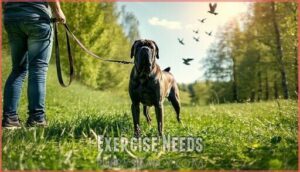This site is supported by our readers. We may earn a commission, at no cost to you, if you purchase through links.
 You’ll find the English Mastiff stands as one of the world’s largest dog breeds, typically weighing 120-230 pounds with males reaching over 30 inches tall.
You’ll find the English Mastiff stands as one of the world’s largest dog breeds, typically weighing 120-230 pounds with males reaching over 30 inches tall.
Their gentle giants combine impressive size with remarkably calm temperaments, making them excellent family guardians who prefer leaning on you for affection rather than showing aggression.
Originally bred as war dogs over 2,000 years ago, today’s English Mastiffs have evolved into loving companions with moderate exercise needs but substantial space and food requirements.
Their protective instincts remain strong, yet they’re naturally sweet with children and respond well to consistent training.
Their shorter 8-10 year lifespan means understanding their specific care needs becomes essential for maximizing your time together.
Table Of Contents
- Key Takeaways
- English Mastiff History
- English Mastiff Appearance
- English Mastiff Temperament
- English Mastiff Care
- English Mastiff Ownership
- Frequently Asked Questions (FAQs)
- Are English Mastiffs good with children and other pets?
- What are some common health issues that English Mastiffs are prone to?
- How much does an English Mastiff typically weigh?
- What age is best to start mastiff puppy training?
- How much does English mastiff surgery typically cost?
- Do mastiffs need special car travel accommodations?
- What temperature ranges are safe for mastiffs?
- How long can mastiffs safely be left alone?
- Conclusion
Key Takeaways
- You’ll own a gentle giant weighing 120-230 pounds who needs substantial space, food (2,200-3,500 calories daily), and budget planning for $3,000-$7,800 annual expenses including premium nutrition and veterinary care.
- You’ll get an excellent family guardian who’s naturally protective yet calm with children, requiring early socialization to prevent overprotectiveness while maintaining their sweet, patient temperament around kids.
- You’ll need to understand their shorter 8-10 year lifespan comes with serious health risks including hip dysplasia (up to 48% prevalence), bloat (26% lifetime risk), and joint issues that require preventive care and weight management.
- You’ll discover these ancient war dogs turned family companions need moderate exercise, consistent positive reinforcement training, and minimal grooming while providing unwavering loyalty and emotional intelligence in family disputes.
English Mastiff History
Your English Mastiff’s ancestry stretches back over 3,000 years to ancient war dogs that impressed even Julius Caesar during his 55 B.C. invasion of Britain.
This gentle giant nearly vanished after WWII with only 14 remaining, but dedicated American breeders saved the breed from extinction.
Ancient Origins
The English Mastiff’s ancient breed lineage stretches back over 3,000 years to Mesopotamian ancestry, where these colossal war dogs first earned their legendary reputation.
Caesar documented their fierce protective nature during Britain’s invasion in 55 BC, noting their formidable presence. The English Mastiff descends from the Molossus, a formidable war dog from ancient Greece.
The breed’s presence is even noted in medieval literary works, such as Chaucer’s Canterbury Tales.
- Mesopotamian ancestry traces to ancient civilizations where these giants served as elite war dogs
- Caesar’s account from 55 BC documented them during his British invasions
- Gladiator battles saw Romans bring them back to fight in the arena
- Breed extinction nearly occurred multiple times throughout their storied dog history
Medieval Era Usage
During medieval times, your english mastiff ancestors served multiple roles across Medieval England.
These ancient breed members worked as Estate Guardians protecting noble properties, Hunting Large Game like wild boar, and fulfilling Wartime Roles alongside knights.
However, their involvement in Blood Sports eventually led to Breed Decline.
Many breeds display protective aggression traits, similar to the Mastiff.
| Role | Purpose | Impact |
|---|---|---|
| Estate Guardians | Protected noble properties | Established loyalty traits |
| Hunting Large Game | Tracked boar and deer | Developed courage |
| Blood Sports | Entertainment battles | Nearly caused extinction |
Modern Revival
World War II nearly destroyed the English mastiff breed, leaving only fourteen dogs alive.
American breeders stepped in during this post-war revival, carefully rebuilding the bloodline through ethical breeding practices.
Today’s breed popularity reflects their success, with the AKC recognizing quality mastiff breeders. You’ll find mastiff rescue options available, though this mastiff history shows how dedicated efforts saved these gentle giants from extinction.
English Mastiff Appearance
You’ll immediately notice the English Mastiff’s impressive size, with males reaching at least 30 inches tall and weighing 130-220 pounds or more.
Their short double coat comes in three standard colors: fawn, apricot, and brindle, complemented by distinctive droopy jowls and a characteristic black facial mask.
Coat Colors
Looking at your massive mastiff’s coat colors, you’ll find three main options: fawn, brindle, and apricot.
Fawn shades range from light cream to deep gold.
Brindle variations feature dark stripes over lighter bases.
Apricot intensity varies from pale peach to rich orange tones.
All mastiff colors include a distinctive dark mask around the muzzle and ears, controlled by color genetics that determine coat patterns.
Their lineage traces back to ancient guarding roles, influencing their size and temperament.
Size and Weight
When you’re considering mastiff size, you’ll discover these giants rank among the largest dog breeds worldwide.
Males typically weigh 150-250 pounds with adult dimensions reaching 30+ inches tall, while females range 120-180 pounds at 27.5+ inches.
Growth rate remains steady until maturity around 18-24 months, and size genetics from parents strongly influence your dog’s final dimensions through breed comparisons.
Distinctive Features
Beyond the impressive mastiff size and weight, your English mastiff displays unmistakable features that make this breed instantly recognizable.
The black mask frames their expressive face, while droopy jowls give them their characteristic appearance.
Key distinctive features include:
- Droopy jowls that create the breed’s signature gentle expression
- V-shaped ears that hang close to the head
- Barrel chest providing their powerful, sturdy build
- Powerful tail that’s moderately high and slightly curved
English Mastiff Temperament
You’ll discover that English Mastiffs are true gentle giants with calm, protective personalities that make them excellent family companions.
Their natural guarding instincts require early socialization to guarantee they remain well-balanced and polite around strangers.
Gentle Nature
Despite their imposing size, English Mastiffs embody the term "gentle giant" with their laid-back demeanor and remarkable child tolerance.
These massive companions prove that the biggest hearts come in the largest packages, offering unwavering loyalty wrapped in gentle strength.
These family-friendly dogs display extraordinary affection levels toward children, often becoming their devoted family protector.
Their gentle demeanor shines during dispute resolution, as these affectionate dogs naturally intervene to restore household harmony with calm, peaceful intervention, showcasing their ability to act as a "family protector".
Protective Instincts
Your Mastiff won’t back down when family faces danger. This courageous nature makes them exceptional guardian dogs, though their protective instincts require careful management.
They’ll watch strangers with aloofness while remaining a loyal protector who intervenes in family disputes with remarkable intuition.
- Family Guardian – Your gentle giant transforms into an unwavering shield when loved ones need protection
- Stranger Aloofness – They’ll keep watchful eyes on newcomers, maintaining polite distance until trust develops
- Dispute Intervention – These peacemakers step between arguing family members with surprising emotional intelligence
- Loyal Protector – Their devotion runs so deep they’ll sacrifice comfort to stay between you and perceived threats
Understanding guard dog traits is essential for managing their protective instincts effectively.
Socialization Needs
Early puppy socialization prevents overprotectiveness and fearfulness in adult Mastiffs.
You’ll need to expose your puppy to various people, animals, sounds, and environments during their critical 8-16 week period.
Proper stranger desensitization and canine interaction help your Mastiff become a well-balanced guardian who distinguishes between real threats and everyday encounters, leading to a more well-balanced life.
English Mastiff Care
Caring for your English Mastiff requires understanding their unique needs as a giant breed.
You’ll need to focus on proper nutrition, moderate exercise, consistent training, regular grooming, and preventive health care to keep your gentle giant happy and healthy.
Diet Requirements
Your English Mastiff’s nutrition needs are substantial—adults require 2,200-3,500 calories daily.
Establish a feeding schedule with two meals to prevent bloat, using high-quality food formulated for giant breeds.
Monitor for food allergies affecting digestive health, and ensure proper meal planning with weight management kibble helps maintain ideal body condition.
Choose mastiff food with balanced protein levels and avoid overfeeding during puppyhood, for peak growth consider Mastiff Dog Food options that cater to their specific needs.
Exercise Needs
While proper nutrition fuels your Mastiff’s growth, regular exercise keeps those massive muscles healthy and joints mobile.
Your gentle giant needs moderate exercise to prevent obesity without stressing developing bones.
- Daily walks for 30-60 minutes maintain cardiovascular health
- Low impact activities protect joints from excessive strain
- Short runs only after 18 months when growth plates close
- Gentle stretches improve flexibility and reduce stiffness
- Outdoor play provides mental stimulation alongside physical activity
Training Methods
Throughout your mastiff training journey, positive reinforcement works like magic with these gentle giants.
You’ll find clicker training particularly effective for obedience commands since Mastiffs respond better to rewards than corrections.
Start housebreaking tips early, establishing clear routines and consistent praise.
Their natural trainability shines through socialization techniques that build confidence.
Remember, dog training tips emphasize patience—your obedience training sessions should stay short and sweet to match their attention span, and this approach is key to successful obedience commands.
Grooming Essentials
Mastiff grooming needs won’t overwhelm your schedule. Their short, double coat requires minimal maintenance, but consistent care keeps them healthy and comfortable.
- Brushing Techniques: Use a rubber curry brush twice weekly to remove loose hair and distribute natural oils
- Shedding Control: Increase brushing frequency during seasonal shedding periods in spring and fall
- Nail Trimming: Clip nails every 3-4 weeks to prevent overgrowth and splitting
- Ear Cleaning: Check and clean ears weekly with veterinarian-approved solution to prevent infections
- Coat Care: Bathe only when necessary using gentle dog shampoo to maintain skin health
Regular grooming tools include a rubber curry to keep their coat clean.
Health Concerns
While proper grooming keeps your mastiff looking great, understanding their health concerns protects your canine companion’s wellbeing.
These gentle giants face several breed-specific conditions that require vigilant monitoring and preventive care. Proper use of mastiff health supplements can help mitigate some of these issues.
| Condition | Prevalence | Prevention/Management |
|---|---|---|
| Hip Dysplasia | Up to 48% | Weight control, screenings |
| Bloat Prevention | 26% lifetime risk | Small frequent meals |
| Joint Issues | Increases after age 7 | Low-impact exercise |
| Degenerative Myelopathy | Genetic screening needed | Early detection is essential |
Canine Obesity worsens most mastiff health problems, making proper diet management your first line of defense against gastric torsion and eye conditions.
English Mastiff Ownership
Owning an English Mastiff means welcoming a gentle giant who’ll become your family’s devoted guardian and couch companion.
You’ll need to keep in mind their specific needs for space, socialization, and the higher costs that come with caring for a dog who can weigh as much as a person.
Family Compatibility
You’ll find that gentle giants fit naturally into most family dynamics.
Their child friendliness shines through protective yet patient behavior with kids.
Consider these family compatibility factors:
- Child Friendliness – Excellent with older children who understand boundaries
- Household Harmony – Sensitive to family disputes, often mediating conflicts
- Social Adaptation – Bonds deeply with all family members
- Loyal Nature – Forms strong protective relationships with children
- Affectionate Temperament – Provides calm, steady companionship for families
When selecting a breed, understanding family dog traits is essential for a harmonious household.
Pet Compatibility
Your gentle giants typically coexist happily with family pets when socialized properly from puppyhood.
Dog socialization helps them learn household dynamics and reduces territorial behaviors around other dogs.
Pet introduction should happen gradually, allowing time for multi pet homes to establish family harmony.
Their calm nature supports peaceful relationships, though early training prevents dominance issues that could disrupt your home’s balance, and helps with dog socialization, and ensures family harmony.
Space and Living Requirements
Your English Mastiff needs spacious housing and accommodating living arrangements to thrive.
These gentle giants require apartment living compromises or a fully fenced yard for ideal comfort. Their large body demands adequate space requirements beyond typical breeds.
Indoor spatial requirements include wide doorways, sturdy furniture, and room to stretch. Consider family dynamics when planning layouts, as these dogs prefer staying close to their pack while respecting exercise needs. They also need to be part of the family dynamics.
Cost and Maintenance
Before diving into ownership expenses, you’ll face substantial ongoing costs with this giant dog breed.
Your mastiff price is just the beginning—feeding costs alone range $900-$2,400 annually, while veterinary care averages $1,200-$2,000 yearly for routine maintenance.
Key ongoing food costs include:
- Monthly feeding expenses: $75-$200 for quality commercial diets
- Annual treat budget: $100-$700 depending on preferences
- Specialized nutrition needs requiring premium formulations for proper growth.
Grooming needs stay minimal at $10-$20 monthly, but dog ownership means budgeting for supplies, insurance, and unexpected expenses totaling $2,998-$7,800 annually.
Owners should research dog care costs to understand the full financial commitment of owning an English Mastiff.
Finding a Reputable Breeder
When searching for mastiff breeders, you’ll need to verify their credentials and commitment to breed standards.
Reputable English Mastiff breeders provide health guarantees and welcome breeder interviews to discuss puppy costs and lineage.
| What to Look For | Red Flags | Questions to Ask |
|---|---|---|
| AKC’s list membership | No health testing | "What health guarantees do you offer?" |
| OFA hip/elbow certifications | Puppies always available | "Can I meet the parents?" |
| Written health guarantees | Multiple breeds/litters | "What’s your return policy?" |
| Breeder interviews required | Won’t show facilities | "Do you screen buyers?" |
| References from previous buyers | Pressure to buy immediately | "What ongoing support do you provide?" |
Quality purebred dogs come from breeders who prioritize health over profit through careful breeder research.
Frequently Asked Questions (FAQs)
Are English Mastiffs good with children and other pets?
Yes, you’ll find these gentle giants excel with children and other pets.
They’re naturally protective of kids while remaining calm and patient.
With proper socialization, they peacefully coexist with cats and dogs, and this is a key aspect of their behavior, particularly in terms of being gentle.
What are some common health issues that English Mastiffs are prone to?
Despite their gentle giant reputation, you’ll face serious health challenges with your Mastiff.
They’re prone to hip/elbow dysplasia, bloat, joint issues, and degenerative myelopathy, requiring careful monitoring throughout their shorter lifespan.
How much does an English Mastiff typically weigh?
English Mastiffs are true heavyweight champions, with males weighing 150-250 pounds and females ranging 120-180 pounds.
You’ll find these gentle giants typically weigh around 120-230 pounds, making them the largest living dog breed.
What age is best to start mastiff puppy training?
Start training your mastiff puppy immediately at 8-12 weeks old. Early socialization and positive reinforcement work best during this critical learning period. You’ll establish good habits before stubborn tendencies develop.
How much does English mastiff surgery typically cost?
Looking to empty your wallet faster than your mastiff empties their food bowl?
Surgery costs for these gentle giants typically range from $1,500 to $8,000, depending on the procedure’s complexity and your location, which can be a significant expense, making surgery costs a crucial consideration.
Do mastiffs need special car travel accommodations?
Yes, you’ll need special accommodations for your giant companion.
Large SUVs or cargo barriers work best, plus heavy-duty harnesses or travel crates.
Their size requires careful planning for safe, comfortable rides.
What temperature ranges are safe for mastiffs?
Surprisingly, your mastiff’s tolerance mirrors outdoor workers’ limits perfectly. Keep them comfortable between 45-75°F, avoiding extreme heat or freezing conditions that stress their massive bodies and breathing.
How long can mastiffs safely be left alone?
You shouldn’t leave mastiffs alone for more than 6-8 hours maximum.
These gentle giants thrive on companionship and can develop separation anxiety, potentially leading to destructive behavior when isolated too long.
Conclusion
Like a gentle giant walking through life, the English mastiff proves that size doesn’t determine temperament.
You’ll discover that owning an English mastiff requires dedication, space, and understanding of their unique needs.
Their short lifespan makes every moment precious, while their loyal nature creates bonds that last forever.
With proper care, training, and love, your English mastiff will become an irreplaceable family member who guards your heart as fiercely as your home.
- https://wagwalking.com/daily/8-unusual-facts-english-mastiff
- https://www.hillspet.com/dog-care/dog-breeds/mastiff
- https://vethelpdirect.com/vetblog/2024/05/07/is-a-mastiff-a-healthy-breed-and-do-they-make-good-pets/
- https://www.akc.org/dog-breeds/mastiff/
- https://www.borrowmydoggy.com/doggypedia/dog-breed-guides-mastiff
















